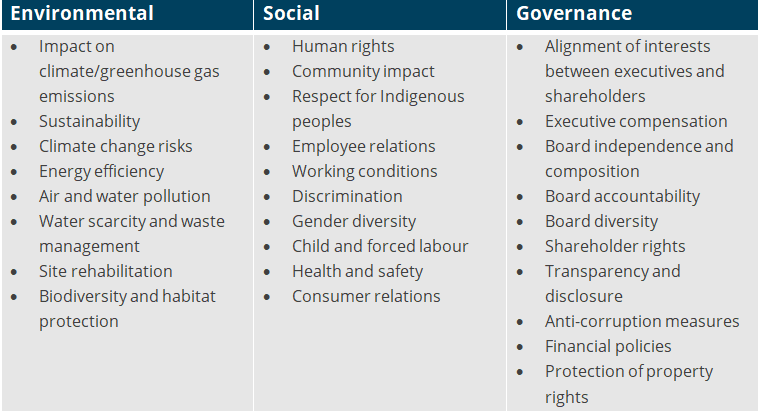When it comes to how to write an ESG policy, the first step is understanding what exactly ESG stands for. At its core, ESG refers to environmental, social, and governance factors that impact a company’s operations and performance.
However, there is no one formula for how to write an ESG policy. It can vary depending on the industry, geographical location, or even the specific project you’re working on.
For example, climate change would be considered an important factor for companies operating in sectors that are directly impacted by emissions reduction targets such as oil and gas but may not be as relevant for those in other industries.
Let’s explore the nuances of writing an ESG policy for different companies.
Table of Contents
How to Write an ESG Policy
An ESG policy is a document that outlines your organization’s commitment to these three areas: environment, social, and governance. While an ESG policy is not required, it can be a helpful tool in defining your purpose.
By outlining your commitment to these three areas, you can begin to see where your values lie.
Do you value environmental sustainability?
Social responsibility?
Good governance?
By writing an ESG policy, you can begin to narrow down what your purpose might be.
Incorporate Stakeholder Feedback
Feedback from interested parties is a crucial part of the ESG policy-making process.
Here are a few tips on how to incorporate feedback from stakeholders.
1. Make a List of Who Your Stakeholders Are
This seems like a no-brainer, but it’s important to take a step back and think about all the groups that have a vested interest in your company’s ESG policies. This could include employees, shareholders, customers, suppliers, and even the general public.
2. Determine How You Will Collect Feedback
There are a variety of ways to collect feedback from stakeholders, so it’s important to choose the method that makes the most sense for your company.
Some companies choose to hold public forums or town halls, while others prefer to collect feedback via surveys or focus groups.

(Source)
3. Listen to the Feedback You Receive
Once you’ve collected feedback from stakeholders, it’s important to take it to heart and use it to inform your policymaking.
Don’t just brush off feedback that you don’t agree with – try to understand where the stakeholder is coming from and see if there’s a way to incorporate their perspective into your policies.
4. Keep Stakeholders Updated on Your Progress
Feedback from stakeholders shouldn’t just be a one-time thing – keep the lines of communication open and let stakeholders know how their feedback is being used to shape your company’s ESG policies.
This could include sending periodic updates or holding regular meetings to discuss progress.
5. Be Prepared to Revise Your Policies
Stakeholder feedback should be used to inform and improve your ESG policies, so be prepared to revise your policies as new feedback comes in. Don’t be afraid to make changes – after all, that’s what the feedback process is all about!
Address the Triple Bottom Line
When it comes to business, the triple bottom line – people, planet, and profit – is becoming increasingly important. And for good reason!
Addressing the needs of all three can help create a more sustainable, ethical, and profitable business.
But what does that actually mean?
And how can you make sure you’re addressing the triple bottom line in your business?
1. Put People First
Your employees are the heart and soul of your business – they deserve to be treated as such! Make sure you have policies and procedures in place that put their safety, health, and well-being first.
2. Go Green
Implementing green policies and practices can help reduce your business’s impact on the environment.
From recycling to using energy-efficient appliances, there are many ways to make your business more sustainable.
3. Be Profitable
Of course, you want your business to be profitable! But that doesn’t mean you have to sacrifice the other two parts of the triple bottom line.
By focusing on sustainable and ethical practices, you can create a business that is good for people and the planet – and that’s good for your bottom line.
Set Objectives and Measure Progress
When it comes to setting objectives and measuring progress, it’s important to have a clear idea of what you want to achieve. But it’s also important to be realistic and to set achievable goals.
After all, there’s no point in setting yourself up for disappointment.
One way to set objectives is to use the SMART method. This stands for Specific, Measurable, Achievable, Relevant, and Time-bound.
In other words, your objectives should be clear and well-defined, you should be able to measure your progress, the goals should be achievable, they should be relevant to your company’s mission and values, and they should have a timeline.
Another way to set objectives is to use the OKR method. This stands for Objectives and Key Results.
The idea here is to set one overall objective and then a number of key results that you want to achieve in order to reach that objective. Once you’ve decided on your objectives, it’s important to measure your progress. This will help you to see how well you’re doing and whether or not you need to make any changes.
There are a number of ways to measure progress, but some of the most common methods include using KPIs, milestones, and targets.
No matter what method you use to set objectives and measure progress, the important thing is to have a system in place that works for you and your team.
Communicate Your ESG Policy
ESG policies can be a great way to communicate your company’s values to employees, customers, and other stakeholders.
But what goes into writing an effective ESG policy?
Here are some things to consider.
1. What are your company’s core values?
Your ESG policy should reflect your company’s core values.
What are you trying to achieve as a business?
What do you stand for?
2. What are your priorities?
Your ESG policy should also highlight your priorities.
What are the most important issues to you and your company?
What do you want to focus on?
3. What are your goals?
Your ESG policy should include specific goals.
What do you hope to achieve with your ESG initiatives?
What are your targets?
4. How will you measure success?
How will you know if your ESG policy is successful?
What metrics will you use to track progress?
5. Who will be responsible for implementation?
Who will be responsible for making sure your ESG policy is carried out?
Who will be accountable for the results?
6. What are the risks and challenges?
What are the risks and challenges associated with your ESG policy?
How will you address them?
7. What are the costs?
What are the costs of implementing your ESG policy?
How will you fund it?
8. What are the benefits?
What are the benefits of implementing your ESG policy?
How will it improve your business?
Answering these questions will help you write an effective ESG policy that meets the needs of your company and stakeholders.
FAQs About How to Write an ESG Policy
What should be included in an ESG policy?
- The diversity of your board.
- How you mitigate supply chain risks.
- Transparency around corporate reporting and engagement with voluntary ESG-related reporting like TCFD.
- Documenting, monitoring, and reporting on your governance, risk, and compliance strategy.
How do you develop an ESG policy?
- Conduct a materiality assessment.
- Establish a baseline.
- Determine objectives and goals.
- Perform a gap analysis.
- Develop your ESG roadmap and framework.
- Implement your plan and measure KPIs.
What is an ESG policy?
ESG investing is the practice of screening companies based on their environmental, social, and governance (or ESG) practices.
How do you write a good ESG report?
- Create an ESG strategy.
- Connect with stakeholders.
- Define goals and metrics.
- Monitor progress.
- Report the results.
Conclusion
The process of how to write an ESG policy can seem daunting, but it’s important to remember that there is no one-size-fits-all approach. Every company is different, and what works for one may not work for another.
The most important thing is to start with a clear understanding of your goals and objectives and incorporate feedback from key stakeholders along the way.
{“@context”:”https:\/\/schema.org”,”@type”:”FAQPage”,”mainEntity”:[{“@type”:”Question”,”name”:”What should be included in an ESG policy?”,”acceptedAnswer”:{“@type”:”Answer”,”text”:”
- \n\t
- The diversity of your board.\n\t
- How you mitigate supply chain risks.\n\t
- Transparency around corporate reporting and engagement with voluntary ESG-related reporting like TCFD.\n\t
- Documenting, monitoring, and reporting on your governance, risk, and compliance strategy.\n
- The diversity of your board.
- How you mitigate supply chain risks.
- Transparency around corporate reporting and engagement with voluntary ESG-related reporting like TCFD.
- Documenting, monitoring, and reporting on your governance, risk, and compliance strategy. “}},{“@type”:”Question”,”name”:”How do you develop an ESG policy?”,”acceptedAnswer”:{“@type”:”Answer”,”text”:”
- \n\t
- Conduct a materiality assessment.\n\t
- Establish a baseline.\n\t
- Determine objectives and goals.\n\t
- Perform a gap analysis.\n\t
- Develop your ESG roadmap and framework.\n\t
- Implement your plan and measure KPIs.\n
- Conduct a materiality assessment.
- Establish a baseline.
- Determine objectives and goals.
- Perform a gap analysis.
- Develop your ESG roadmap and framework.
- Implement your plan and measure KPIs. “}},{“@type”:”Question”,”name”:”What is an ESG policy?”,”acceptedAnswer”:{“@type”:”Answer”,”text”:”
ESG investing is the practice of screening companies based on their environmental, social, and governance (or ESG) practices. “}},{“@type”:”Question”,”name”:”How do you write a good ESG report?”,”acceptedAnswer”:{“@type”:”Answer”,”text”:”
- \n\t
- Create an\u00a0ESG strategy.\n\t
- Connect with stakeholders.\n\t
- Define goals and metrics.\n\t
- Monitor progress.\n\t
- Report the results.\n
- Create an\u00a0ESG strategy.
- Connect with stakeholders.
- Define goals and metrics.
- Monitor progress.
- Report the results. “}}]}





